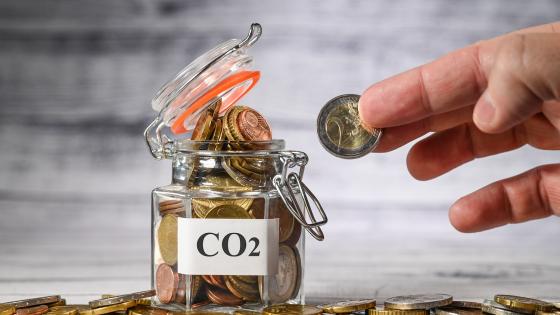Carbon pricing has become a central tool in Europe’s strategy to mitigate climate change, but remains politically contentious, as the ‘yellow vest’ movement in France illustrates (Fabre 2022). Indeed, in recent years, many populist and extremist parties across Europe have positioned themselves against climate action. Despite its effectiveness in reducing emissions, instruments like the EU Emissions Trading System (EU ETS) can impose uneven economic costs and potentially trigger political backlash. Understanding these impacts is especially important given the EU ETS’s planned expansion to cover emissions from buildings and transportation sectors starting in 2027.
This column builds on Konradt and Mangiante (2025) to empirically assess the distributional and political implications of carbon pricing across European regions. Based on a newly compiled dataset encompassing 224 major regions from 20 countries over two decades, we estimate the dynamic effects of carbon price changes in the EU ETS. To identify exogenous variation, we rely on the carbon policy shock series developed in Känzig (2023), which exploits high-frequency movements in carbon price futures around key regulatory announcements and is designed to be independent of confounding macroeconomic conditions.
In line with a growing literature on the effects of carbon pricing, we find that higher carbon prices reduce emissions but impose economic costs, as measured by a decline in output and employment. Our first insight is that carbon pricing also has significant political consequences. We estimate that higher carbon prices contribute to larger vote shares for extremist, populist, and Eurosceptic parties in upcoming elections. These findings are consistent with extremist parties gaining support during periods of economic distress and recessions (e.g. Guriev 2018).
Our second insight is that the economic and political costs are borne unequally across regions and countries. Regions that are more exposed to carbon pricing – either due to higher emission intensity or a lower allocation of free allowances – experience a stronger economic slowdown. In other words, the EU ETS has been a driver of regional inequality according to our estimates. Lastly, regions bearing higher economic costs associated with carbon pricing also exhibit a stronger shift to extremist political parties.
The economic and political effects of carbon pricing
We begin by estimating the effects of an identified carbon policy shock on emissions and economic activity across European regions. Figure 1 presents dynamic impulse responses over a four-year horizon following a carbon policy shock calibrated to raise energy prices by 1% on impact. The estimates suggest that carbon pricing effectively lowers emissions, but it is associated with economic costs (e.g. Känzig 2023, Konradt and Känzig 2024, Mangiante 2024): we see a significant contraction in regions’ aggregate output, employment, as well as household income.
Figure 1 Economic impacts of a carbon policy shock
Notes: The figure plots the response to a carbon policy shock, normalized to increase the Euro Area HICP energy by one percent on impact, for regional GHG emissions and different economic variables. Shaded areas denote 68 and 90 percent confidence bands, based on Driscoll and Kraay (1998) standard errors.
Do higher carbon prices and the associated economic costs have political consequences? To address this question, we estimate similar impulse responses for the regional vote share of extremist and populist parties in national and European elections (Rooduijn et al. 2023). Figure 2 shows that higher carbon prices are associated with a significant increase in support for these parties over the medium term. Decomposing the response of the extremist vote share, carbon policy shocks primarily induce a shift towards far-right parties, which often gain support during episodes of economic distress (Funke et al. 2016). Moreover, we estimate similar effects for Eurosceptic parties and find that measures of political fragmentation increase following carbon policy shocks. In sum, our results indicate that higher carbon prices impose significant political costs.
Figure 2 Political impacts of a carbon policy shock
Notes: The figure plots the response to a carbon policy shock, normalized to increase the Euro Area HICP energy by one percent on impact, for the regional vote share of extremist and populist parties. Shaded areas denote 68 and 90 percent confidence bands, based on Driscoll and Kraay (1998) standard errors.
The heterogeneous effects across regions
The average effects reported in Figures 1 and 2 mask potentially important heterogeneity in the impacts across regions. We therefore explore two dimensions of regional exposure to carbon pricing. First, regions with a carbon-intensive industrial base (measured as emissions to GDP) are potentially more exposed to rising carbon prices. Second, the EU ETS’s allocation of free allowances creates a mitigating effect: regions that receive a higher share of allowances relative to emissions face a lower effective carbon price.
Figure 3 illustrates substantial variation in regions’ exposure to the EU ETS, even within countries. For instance, regions in eastern and southern Europe tend to have some of the highest carbon intensities. In Germany, regional carbon intensities are notably higher in the east and west compared to the north and south of the country. By contrast, the share of free allowances (not reported here) is highest in northern and eastern European regions.
Figure 3 ETS intensity across European regions
Notes: The figure plots the regional EU ETS intensity in 2008, defined as verified emissions scaled by GDP. The thresholds for the quintiles are 3.8%, 7.2%, 14.6% and 26%, respectively. Data for Latvia are missing.
To formally assess the role of regions’ carbon intensities and share of free allowances, we extend our baseline model by interacting the carbon policy shocks with the relevant region-specific exposure measures. To facilitate interpretation, we standardise the exposure measures and report similar dynamic effects as before for a region with a one standard deviation higher exposure relative to the average region.
Figure 4 presents the interaction coefficients for regional GDP and the extremist vote share. The findings suggest substantial heterogeneity in the economic responses to carbon policy shocks. Regions with higher carbon intensity (panel a) and receiving a lower share of free allowances (panel b) experience a sharper decline in output. In addition, we estimate more severe labour market impacts in these regions. These results imply that carbon pricing, through its unequal impacts on output and employment, contributes to regional inequality. Indeed, our estimates suggest that direct measures of regional inequality within a country – such as the 90–10 ratio of disposable household income – increase in response to higher carbon prices.
Figure 4 Unequal economic and political impacts of a carbon policy shock
Notes: The figure plots the response of real GDP and the extremist vote share to a carbon policy shock, normalised to increase the Euro Area HICP energy by one percent on impact, for (a) regions with a standard deviation higher EU ETS intensity (verified emissions relative to GDP), and (b) regions with a standard deviation lower share of free allowances to total emissions. Shaded areas denote 68 and 90 percent confidence bands, based on Driscoll and Kraay (1998) standard errors.
Importantly, regions bearing larger economic costs from carbon pricing also experience a stronger shift toward extremist parties according to our estimates. The interaction effects for both exposure measures (Figure 4) are positive and precisely estimated. Our results are consistent with an economic voting channel, in which extremist parties benefit from recessionary periods (Funke et al. 2018) and rising inequality (Pástor and Veronesi 2021).
To further support this channel, we explore regional data from the cross-country Eurobarometer survey. We estimate that a similar increase in carbon prices leads to a deterioration in households’ economic expectations, and environmental issues decline in priority among respondents’ self-reported concerns.
Lastly, comparing the regional impacts of carbon policy shocks to conventional oil price shocks suggests that the economic costs are comparable, but carbon pricing is associated with a stronger political response. One interpretation is that voters punish elected officials for the economic impacts of carbon pricing, but view oil prices as beyond their control.
Concluding remarks
This column shows that carbon pricing in Europe is associated with unequally distributed economic impacts and political consequences in the form of more extremist voting. To address the uneven economic impacts of carbon pricing and limit political backlash, complementary measures such as direct rebates of tax revenues to household – ideally in a progressive manner – are necessary (e.g. Fried et al. 2024). Moreover, effective public communication about the long-term benefits of carbon pricing can play a key role in rebuilding broader support for climate policy (e.g. Schwarz et al. 2024).
References
Fabre, A (2022), “Yellow vests and carbon taxes”, VoxTalk.
Fried, S, K Novan and W B Peterman (2024), “Understanding the inequality and welfare impacts of carbon tax policies”, Journal of the Association of Environmental and Resource Economists 11: 231–260.
Funke, M, M Schularick and C Trebesch (2016), “Going to extremes: Politics after financial crises, 1870–2014”, European Economic Review 88: 227–260.
Guriev, S (2018), “Economic drivers of populism”, AEA Papers and Proceedings 108: 200-203.
Känzig, D R (2023), “The unequal economic consequences of carbon pricing”, NBER Working Paper 31221.
Känzig, D R (2023), “Climate policy and economic inequality”, VoxEU.org, 25 June.
Känzig, D R and M Konradt (2024), “Climate policy and the economy: Evidence from europe’s carbon pricing initiatives”, IMF Economic Review 72: 1081–1124.
Känzig, D R and M Konradt (2024), “The economic effects of carbon pricing”, VoxEU.org, 12 August.
Konradt, M and G Mangiante (2025), “The Unequal Costs of Carbon Pricing: Economic and Political Effects Across European Regions”, SSRN Working Paper.
Mangiante, G (2024), “The geographic effects of carbon pricing”, European Economic Review 168, 104825.
Pástor, L and P Veronesi (2021), “Inequality aversion, populism, and the backlash against globalization”, The Journal of Finance 76: 2857–2906.
Rooduijn, M, A L Pirro, D Halikiopoulou et al. (2023), “The populist 3.0: An overview of populist, far-left and far-right parties in Europe”.
Schwarz, C, L Engelmann, A Löschel and M Willinger (2024), “Tailored information campaigns increase public support for carbon pricing”, SSRN Working Paper.








